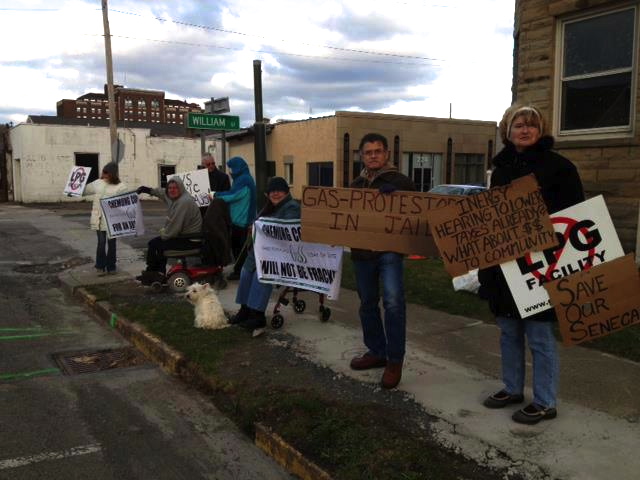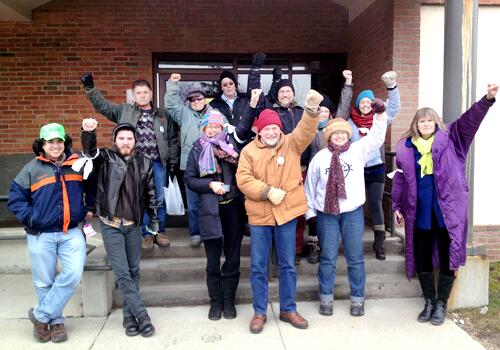Sandra Steingraber, the renowned biologist, author, poet and cancer survivor, just served a 15-day sentence for interfering with the smooth, forward motion of the burgeoning fracking industry. In March, Ithaca College’s Distinguished Scholar in Residence in Environmental Studies and Science joined the Seneca Lake 12 in blocking the driveway of Inergy Midstream, an energy storage and transportation company in upstate New York that plans to pump highly pressurized gas derived from far-off fracking fields into salt caverns along and under a lake which provides drinking water for 100,000 people in the area. She and two others — Melissa Chipman and Michael Dineen — were sentenced to jail time after refusing to pay $375 fines.
For a quarter century Dr. Steingraber has ceaselessly researched, documented, written about and worked against the hazards of industrial impacts on the planet and its inhabitants. Integrating powerful prose with scientific findings, her pivotal books includeLiving Downstream: An Ecologist Looks at Cancer and the Environment, 1997; Having Faith: an Ecologist’s Journey to Motherhood, 2001; and Raising Elijah: Protecting Our Children in an Age of Environmental Crisis, 2011. At the same time, she has been active in New York’s campaign to prevent fracking in the state.
Her sentence in the Chemung County Jail in Elmira, N.Y., which began on April 17 — just hours after being interviewed by Bill Moyers on his public affairs program — hasn’t seemed to slow her down. Before going in, she told 350.org’s Bill McKibben that she planned to use her time to carry on with writing projects and a list of other tasks.
A part of this work-plan, presumably, was the letter that ran on Common Dreams on Earth Day that she had written in her cell “with a borrowed pencil on the back of the ‘Chemung County Inmate Request Form,’ which is a half sheet of paper.” (This scarcity of writing materials calls to mind Dr. Martin Luther King, Jr. scratching out the “Letter from a Birmingham Jail” on toilet paper and along the margins of a handy newspaper 50 years ago this month.) In addition to commenting on the jail’s surreal arbitrariness, rote institutional heartlessness, and even a small act of inmate resistance followed by an unexpected victory — all on display in the first couple of days inside — Steingraber shares three reasons she’s chosen to go to jail.
First, to resist the industrialization of the Finger Lakes region that will “aid and abet the fracking industry by erecting a massive storage depot near the birthplace of my son.”
Second, to respond to a recent commentary by economist Jeremy Grantham published in the journal Nature. Real-life data is overtaking even the worst-case scenarios for climate change, Grantham wrote, therefore scientists must take action. “Be persuasive, be bold, be arrested (if necessary),” he urged. Steingraber decided to answer this call.
Third, to signal her commitment to resisting the mounting extinction of species. This pledge was rooted in an experience she had had several years ago when her son had asked her to make him a polar bear costume for Halloween and, as she was doing so, she became acutely aware that this outfit would likely outlive the species itself. “Out on the street that night I saw many species heading towards extinction; children dressed as frogs, bees, monarch butterflies, and the icon of Halloween itself — the little brown bat. The kinship that children feel for animals and their ongoing disappearance from us literally brought me to my knees that night, on a sidewalk in my own village. It was love that got me back up. It was love that brought me to this jail cell,” Steingraber wrote.
This letter (and another missive she dispatched from jail to environmental organizations, also on Earth Day) stresses the indissoluble link between the personal and the political. Steingraber’s writing typically brings the wealth of scientific data into focus with the particularity of lives directly impacted by massive economic, political and environmental forces of industrialized society. It began with her own experience of bladder cancer in her 20s (with indications that it was related to an apparent cancer cluster in her hometown and within her family) and has been an enduring focus of much of her research in one way or another. It also comes through in the poignancy of her book titles, striking a chord both deeply personal and almost uniformly applicable to people everywhere.
Real lives and real bodies are impacted by the regime of toxics within which we subsist — a fact that sharpens the meaning and power of Steingraber’s act of civil disobedience, which is nothing if not embodied resistance. Nonviolent change ultimately hinges on launching and sustaining a powerful, searching and inclusive conversation across society in order to wrestle with the problems before us and to achieve effective solutions. Often this means a long-term process of a society changing its mind. If we have been taught nothing else over the past century since Gandhi illuminated the potential for nonviolent social transformation, the most powerful language at our disposal for this conversation are our vulnerable, unarmed, resilient and grounded bodies. It is not enough to enunciate our opposition or write out our positions. We must put our entire selves forward.
In the face of the monumental risks to the body of the world (and all the bodies that huddle across it) posed by the toxic tsunami we face, Steingraber and others are putting their own bodies a bit at risk by standing in the way of the catastrophe’s seeming inevitability. By doing so, they begin to counter what Steingraber has called “informed futility syndrome” — the way greater knowledge about a problem actually can incapacitate us. The more we know, the more paralyzed we often become. Taking action, placing our bodies in the nonviolent fray, has a way of thawing out our frozen immobility.
Another theme of Gandhi’s seems to be operating here. He called his autobiography My Experiments with Truth, which largely consisted of stories about his experimentation with nonviolence in his own life and in the larger world. Using a basic version of the scientific method, he learned by doing, and invited his readers to do the same. Don’t take my word for the power of nonviolent resistance, he seemed to say. Go out and experiment with this yourself! Scientist Sandra Steingraber has been conducting a long-term experiment on the viability and sustainability of the planet and the well-being of its inhabitants. Can we sound the alarm? Can we change direction? What will it take? Now the mounting data has led her to her next experiment — going to jail — because she does not want only to explain the world but to change it.
By doing so, she stands in a long line of scientists who are led not simply to analyze but to translate their findings into action, like the Manhattan Project scientists who turned away in horror at what they created in the New Mexico desert and formed the basis of the enduring anti-nuclear weapons movement; or Carl Sagan, who was led by his grasp of the beauty of the universe to warn us of nuclear winter and to be arrested at the Nevada Test Site engaging in nonviolent civil disobedience in 1987; or James Hansen, the former head of NASA’s Goddard Institute for Space Studies who has “spoken truth to power” about climate change, and has faced the consequences for doing so.
Scientists conduct experiments to increase humanity’s knowledge and to establish practical applications. If we think of Sandra Steingraber’s act of civil disobedience not simply as a political witness but as a scientific experiment, it will meet its objective only, like all experiments, when its outcomes can be verified over and over again. In this case, it would mean replicating outcomes like freeing us from our debilitating incapacity for change, deepening and broadening a movement for a sustainable world, or actually seeing this world starting to come into being.
Dr. Sandra Steinberger is behind bars. If we want to honor her witness, we can take up the experiment she’s been working on and replicate it in our own way. (One possibility for doing so is to consider joining the 59,535 people who have signed the Keystone XL Pledge of Resistance, a commitment to engage in nonviolent resistance.) Inspired by Steingraber and a growing international movement, we have an opportunity to conduct our own nonviolent experiment with truth for a more sustainable world.
Originally published by Waging Nonviolence
3 WAYS TO SHOW YOUR SUPPORT
- Log in to post comments















